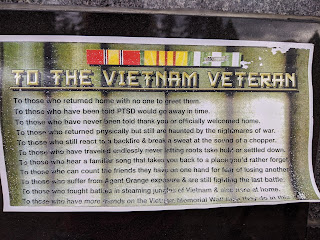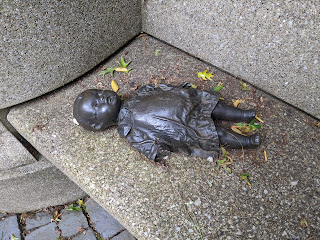Steven and I had arrived in Portland the night before from Bend after exploring central Oregon on our road trip of the Pacific Northwest. Our trip began after visiting our first born granddaughter, Max, in San Francisco. Portland, at the confluence of the Columbia and Willamette rivers, had once been a stop on a trading route used by Chinook Native Americans. In the 1840s, one Bostonian and one former resident of Portland, Maine, envisioned a large clearing as the site for a new town. They called it Stumptown initially because so many trees had been removed for campfires leaving only stumps. But both men wanted the new town to be named after their hometown so a coin toss with the Portland Penny decided the issue!
We started our tour of Portland at Washington Park, rightly described as the crown jewel of the city's extensive park system because it contained an arboretum, children's museum, zoo, rose garden, Japanese garden, Holocaust and Vietnam memorials, as well as plenty of monuments celebrating the city's heritage! Located in one corner of the park by the Hoyt Arboretum was the Vietnam Veterans of Oregon Memorial which was dedicated to the Oregonians who served in the Vietnam War. It was immediately apparent that the memorial was the largest and most impressive of any we'd made it a point to explore in other cities.
To access the memorial at the top of a hill, we walked up a spiral path above a manicured sunken area.
Monuments in black granite along the path were year-specific from the onset of tensions in SE Asia in 1959 and listed the names of those service members who died or were reported as missing. A history of the events in Oregon during each year of the war was also inscribed at the top of each wall. That combination really helped put everything into context for us.
It was so heartbreaking seeing the far longer list of names as the war escalated in 1966 and 1967.
I was glad to see that visitors to the memorial were asked to limit 'active recreation' to areas outside the memorial bowl or sunken area in respect for those who came seeking solace.
Here are just the first two lines of a poem titled To the Vietnam Veteran that gripped me:
To those who returned home with no one to greet them.
To those who have been told PTSD would go away in time.
I urge you in the strongest possible way to click on the poem to make it larger so you can read of the heartache felt by so many veterans returning home after serving their country.
These six simple words were among the most powerful I could remember reading or hearing for years and years.
I recommend you click on this photo to read about the faraway war's effect on Oregonians.
The last monument depicting events in Oregon during the war stated: "Such then were some of the happenings in Oregon during these years of war, events both grave and bitter, nonsensical and normal, spectacular and ordinary, the multitudinous life of a place which these 751 men were not to see again."
Lest we never forget those brave men who were declared Missing in Action, a fate worse than hell for their loved ones back home.
Complementing the memorial were profusions of baby pink dogwood flowers that were themselves a living memorial. As the memorial garden continued to grow and change, it was a consistent reminder of the importance of living things, and a positive place of reconciliation, healing, and life.
The memorial, though sad on one level because of its very nature, was still a place of beauty and serenity to ponder the heroism and loyalty that distinguished the men and women who served in Southeast Asia.
Also located in in a grove of pine trees in Washington Park was the Oregon Historical Memorial. The idea for the memorial to those who died in the Holocaust came about in 1994 by local survivors who suffered the most terrible experiences of prejudice and hate. The memorial featured a stone bench adorned with wrought-iron gating which sat behind by a cobblestoned area to simulating a town square.
During the Holocaust, many Jewish families had been gathered in town squares before being loaded onto trains and taken to concentration camps. The square contained scattered bronzes of baby shoes, glasses, a suitcase, and other items to represent everyday objects that were left behind. It almost brought us to tears seeing these objects placed seemingly randomly around the site.
The memorial's semi-circular shape and inset panels reminded me right away of the Columbine Memorial in our hometown of Littleton, Colorado. On either side of the memorial were giant, stone walls with a brief history of the Holocaust.
The inlaid granite bars with quotes from Holocaust survivors intentionally simulated train tracks. Though the quotes were harrowing to read, we couldn't not read them as they were so gripping. To read them for yourself, click on each one to make it bigger. I assure you the extra effort is worth it as we'd never seen anything like it at Holocaust memorials in Europe and Israel.
Beneath the rock were interred soil and ash from six Holocaust concentration camps: Auschwitz-Birkenau, Belzek, Chelmo, Majdanek, Sobibor, and Treblinka.
The back of the wall was engraved with the names of people who died in the camps, followed by the names of their surviving relatives in Oregon and SW Washington.
A sign at the memorial said: "In the end, that a handful of people among us did survive the Holocaust is a matter of luck and of their own personal will. And as do their fellow survivors elsewhere, they recall that life or death often rested on nothing more certain than the impulse of others: the courage of a rescuer, the goodness of a stranger, the sacrifices of their liberators. With this memorial, the living have borne witness."
In a secluded and isolated section of Washington Park was a fantastic sculpture, Coming of the White Man, completed in 1904, that featured two Native Americans looking down upon the route that ox teams trudged bringing settlers to this part of the country. The older of the two is said to be Chief Multnomah of the Multnomah people.
I read on the Portland Public Art website that "Native peoples, conceived of as mysterious, dangerous and ignorant by white pioneers and their artists, were often depicted in artwork of the time as stunned, entranced, or thrilled by the invasion of covered wagons. Later, when what we now call genocide began to sink in to the white consciousness, images of Native people transformed to defeated warriors, beautiful squaws, vast landscapes overwhelming tiny teepees, and later again, with photography, severe portraits of alien and rough strangers."
Nearby was the statue erected by the women of the US in memory of Sacajawea, the only woman in the Lewis and Clark expedition, and in honor of the of the pioneer mother of old Oregon.
Next post: The City of Roses aka Portland's International Rose Test Garden.
Posted on September 29th, 2020, from "our happy place" at a state park on the Florida Panhandle. Steven and I hope that you and your loved ones say healthy, stay safe, and especially stay connected during these extraordinarily tough times.

































No comments:
Post a Comment